The Intel Haswell-E CPU Review: Core i7-5960X, i7-5930K and i7-5820K Tested
by Ian Cutress on August 29, 2014 12:00 PM ESTGaming Benchmarks
One of the important things to test in our gaming benchmarks this time around is the effect of the Core i7-5820K having 28 PCIe 3.0 lanes rather than the normal 40. This means that the CPU is limited to x16/x8 operation in SLI, rather than x16/x16.
F1 2013
First up is F1 2013 by Codemasters. I am a big Formula 1 fan in my spare time, and nothing makes me happier than carving up the field in a Caterham, waving to the Red Bulls as I drive by (because I play on easy and take shortcuts). F1 2013 uses the EGO Engine, and like other Codemasters games ends up being very playable on old hardware quite easily. In order to beef up the benchmark a bit, we devised the following scenario for the benchmark mode: one lap of Spa-Francorchamps in the heavy wet, the benchmark follows Jenson Button in the McLaren who starts on the grid in 22nd place, with the field made up of 11 Williams cars, 5 Marussia and 5 Caterham in that order. This puts emphasis on the CPU to handle the AI in the wet, and allows for a good amount of overtaking during the automated benchmark. We test at 1920x1080 on Ultra graphical settings.
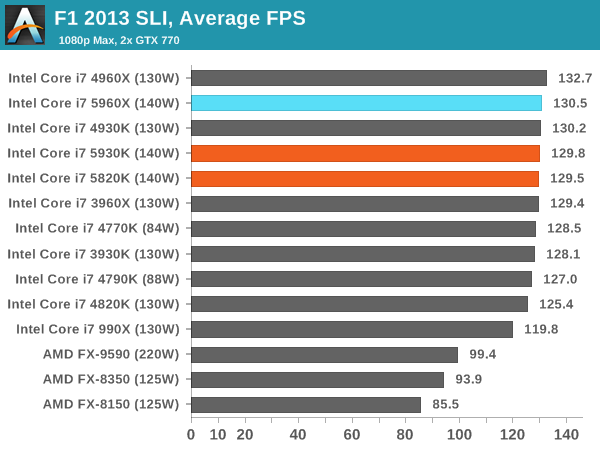
Nothing here really shows any advantage of Haswell-E over Ivy Bridge-E, although the 10% gaps to the 990X for minimum frame rates offer some perspective.
Bioshock Infinite
Bioshock Infinite was Zero Punctuation’s Game of the Year for 2013, uses the Unreal Engine 3, and is designed to scale with both cores and graphical prowess. We test the benchmark using the Adrenaline benchmark tool and the Xtreme (1920x1080, Maximum) performance setting, noting down the average frame rates and the minimum frame rates.
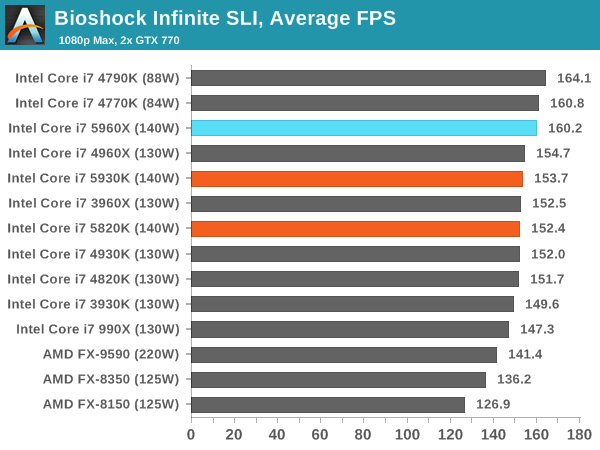
Bioshock Infinite likes a mixture of cores and frequency, especially when it comes to SLI.
Tomb Raider
The next benchmark in our test is Tomb Raider. Tomb Raider is an AMD optimized game, lauded for its use of TressFX creating dynamic hair to increase the immersion in game. Tomb Raider uses a modified version of the Crystal Engine, and enjoys raw horsepower. We test the benchmark using the Adrenaline benchmark tool and the Xtreme (1920x1080, Maximum) performance setting, noting down the average frame rates and the minimum frame rates.
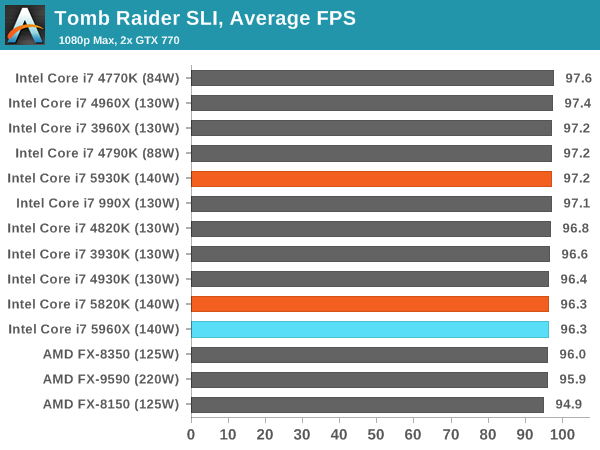
Tomb Raider is blissfully CPU agnostic it would seem.
Sleeping Dogs
Sleeping Dogs is a benchmarking wet dream – a highly complex benchmark that can bring the toughest setup and high resolutions down into single figures. Having an extreme SSAO setting can do that, but at the right settings Sleeping Dogs is highly playable and enjoyable. We run the basic benchmark program laid out in the Adrenaline benchmark tool, and the Xtreme (1920x1080, Maximum) performance setting, noting down the average frame rates and the minimum frame rates.
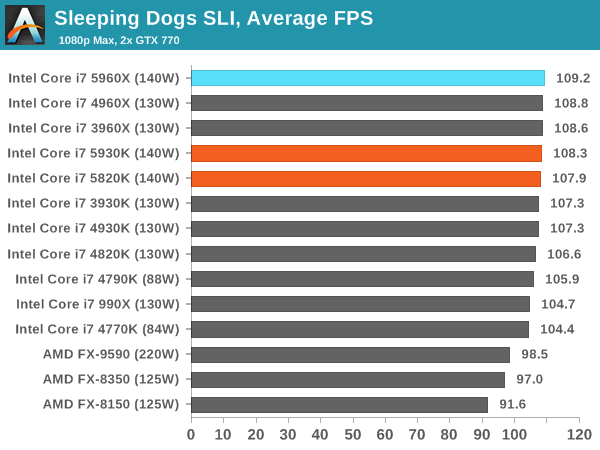
The biggest graph of CPU performance change is the minimum frame rate while in SLI - the 5960X reaches 67.4 FPS minimum, with only the xx60X CPUs of each generation moving above 60 FPS. That being said, all the Intel CPUs in our test are above 55 FPS, though it would seem that the 60X processors have some more room.
Battlefield 4
The EA/DICE series that has taken countless hours of my life away is back for another iteration, using the Frostbite 3 engine. AMD is also piling its resources into BF4 with the new Mantle API for developers, designed to cut the time required for the CPU to dispatch commands to the graphical sub-system. For our test we use the in-game benchmarking tools and record the frame time for the first ~70 seconds of the Tashgar single player mission, which is an on-rails generation of and rendering of objects and textures. We test at 1920x1080 at Ultra settings.
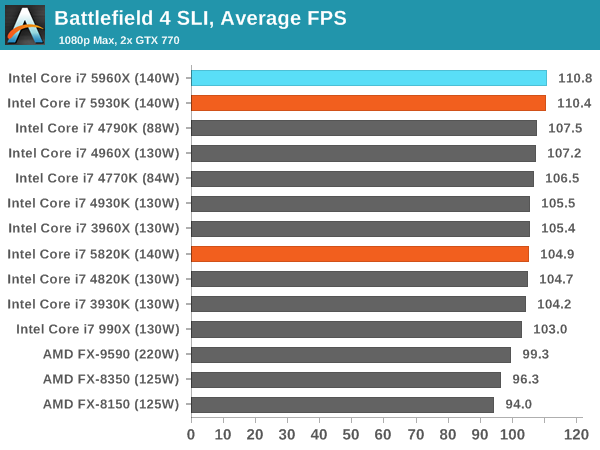
Battlefield 4 is the only benchmark where we see the 5820K with its 28 PCIe lanes down by any reasonable margin against the other two 5xxx processors, and even then this is around 5% when in SLI. Not many users will notice the difference between 105 FPS and 110 FPS, and minimum frame rates are still 75 FPS+ on all Intel processors.


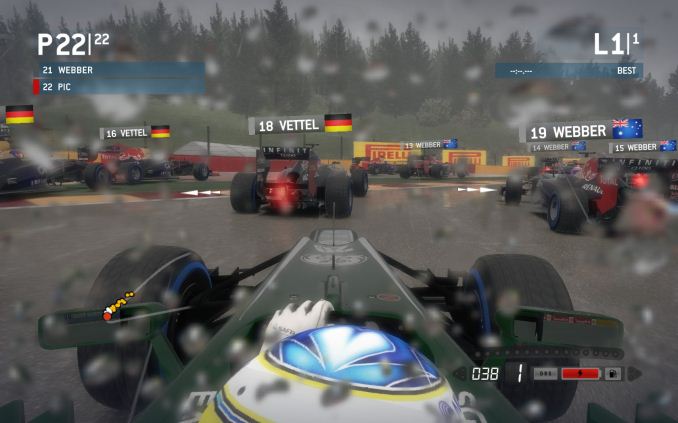
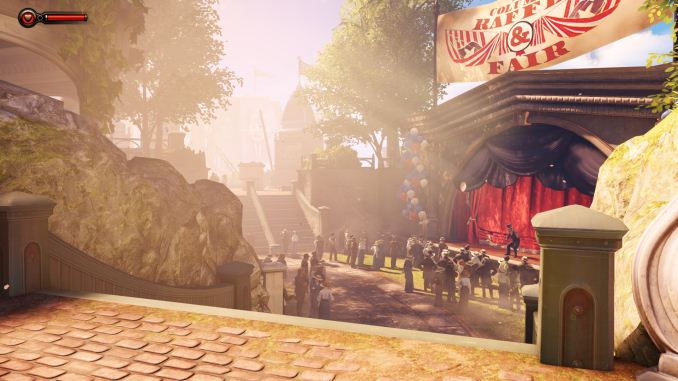


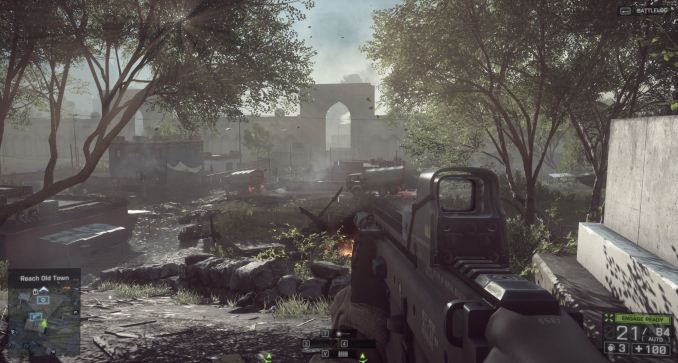








203 Comments
View All Comments
mapesdhs - Saturday, August 30, 2014 - link
I agree; I'd been hoping for a midrange 8-core of some kind, but Intel's once
again shoved up the peformance/price scale purely because it can. Shame.
And IMO the PCIe provision chop with the 5820K is in the wrong direction;
by that I mean the 5820K should have 40, the 5930K have 60 and the 5960X
given 80, something like that. Supporting 4-way native x16 with enough left
over for good storage at the top-end of the CPU range would make its price
much more tolerable, but now the price difference is really just the +2 cores,
at a time when the mid-range chip ought to be an 8-core anyway (remember
the 3930K was an 8-core but with 2 cores disabled, ie. Intel could have
released a consumer 8c a long time ago).
Ian.
PS. twtech, I've benched oc'd 3930Ks quite a lot. What do you use your system for?
garadante - Friday, August 29, 2014 - link
Sheesh... Looking at these performance reviews, I'm questioning whether or not I'll even go for an -E series when I invest in a full upgrade from my 2500k in 2-3 years. In many scenarios the 4790k is at the top or near the top of the rankings due to the higher clock speeds stock/overclocked, yet the platform is much cheaper. Perhaps the 4790k equivalent 2-3 generations from now will be 6-cores, or the IPC will start going up if Intel focuses on it (I hope, but unlikely...). Otherwise these systems are just too expensive for little gain except in CPU bound workloads.l_d_allan - Friday, August 29, 2014 - link
same, with 2600kStevoLincolnite - Friday, August 29, 2014 - link
Same, I'll stick with my Core i7 3930K which happily hits 5ghz.Years ago I never would have thought a CPU released 3 years prior to the latest and greatest would still be able to compete/beat the top chips in most scenarios.
Hopefully Haswell-E's successor gives me the upgrade itch and maybe DDR4 drops in price by then, by then my platform would be 4+ years old.
Intel sure does make it hard to justify plonking down a few grand though. :(
Mithan - Friday, August 29, 2014 - link
I am waiting for skylake next year.Samus - Saturday, August 30, 2014 - link
i7-920 at 3.5GHz/X58 here (first DDR3 chipset)I was going to hold out for the first DDR4 chipset to replace this thing, but...maybe I'll wait for DDR5. Even 5 years later, my first-gen i7 is faster than like 90% of the desktop CPU's out there TODAY. Intel really outdid themselves with Nehalem.
xrror - Saturday, August 30, 2014 - link
Anyone still on 1366, I'd recommend searching around on ebay for xeon X5650 's that are getting dumped for less than $100. If your motherboard is alright with a 191BCK guess what - 4.2Ghz Gulftown with full 6(12) cores. Yeay =)DPOverLord - Sunday, August 31, 2014 - link
I upgraded from a i7 930 to a xeon 5650. Its at 4.6ghz with sli titans in surround (4800 x 2560). Based on this x99 seems to be a worthwhile upgrade albeit an expensive one. Anyone else in my boat?getho - Tuesday, September 2, 2014 - link
So is it worth upgrading an i7 @3.2 GHz to the x5650? My bottleneck is single thread performance (light room likes fast chips).xaml - Saturday, September 27, 2014 - link
I might give this a try once I stuff that Studio XPS 435 MT motherboard sporting an i7 940 into a Prodigy M. I actually had a look at compatible new processors, but they were too expensive. I am not sure if I am going to trust a used offer though.